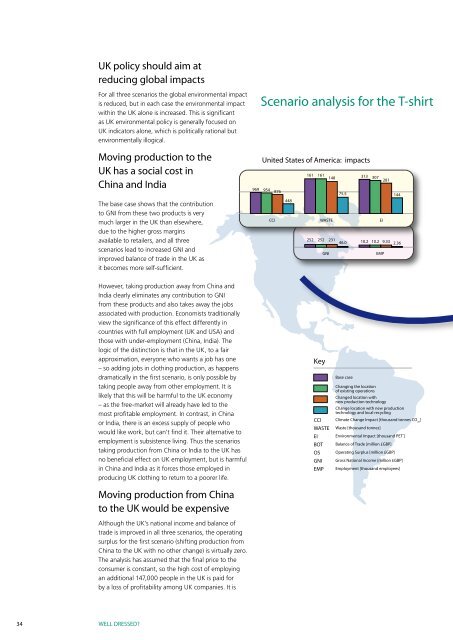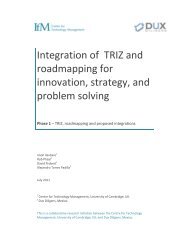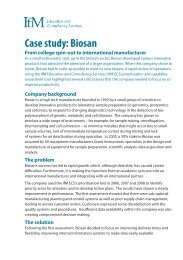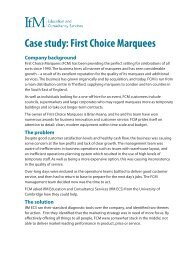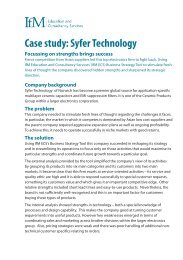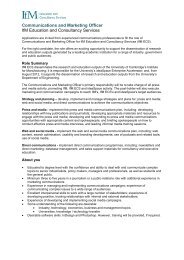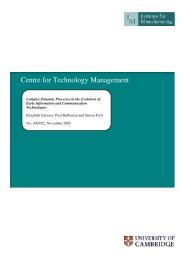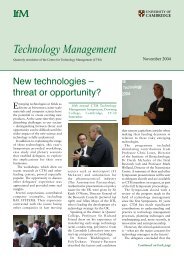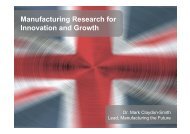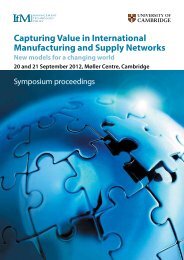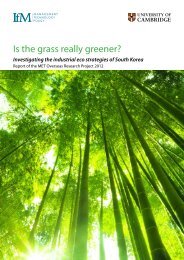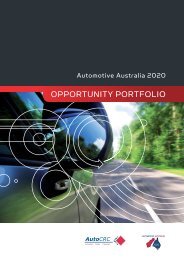The present and future sustainability of clothing and textiles in the ...
The present and future sustainability of clothing and textiles in the ...
The present and future sustainability of clothing and textiles in the ...
Create successful ePaper yourself
Turn your PDF publications into a flip-book with our unique Google optimized e-Paper software.
UK policy should aim at<br />
reduc<strong>in</strong>g global impacts<br />
For all three scenarios <strong>the</strong> global environmental impact<br />
is reduced, but <strong>in</strong> each case <strong>the</strong> environmental impact<br />
with<strong>in</strong> <strong>the</strong> UK alone is <strong>in</strong>creased. This is significant<br />
as UK environmental policy is generally focused on<br />
UK <strong>in</strong>dicators alone, which is politically rational but<br />
environmentally illogical.<br />
Mov<strong>in</strong>g production to <strong>the</strong><br />
UK has a social cost <strong>in</strong><br />
Ch<strong>in</strong>a <strong>and</strong> India<br />
<strong>The</strong> base case shows that <strong>the</strong> contribution<br />
to GNI from <strong>the</strong>se two products is very<br />
much larger <strong>in</strong> <strong>the</strong> UK than elsewhere,<br />
due to <strong>the</strong> higher gross marg<strong>in</strong>s<br />
available to retailers, <strong>and</strong> all three<br />
scenarios lead to <strong>in</strong>creased GNI <strong>and</strong><br />
improved balance <strong>of</strong> trade <strong>in</strong> <strong>the</strong> UK as<br />
it becomes more self-sufficient.<br />
Scenario analysis for <strong>the</strong> T-shirt<br />
United States <strong>of</strong> America: impacts<br />
161 161<br />
148<br />
313 307<br />
281<br />
969 954 876<br />
75.5<br />
144<br />
448<br />
CCI<br />
WASTE<br />
EI<br />
252 252 231 46.0 10.2 10.2 9.33 2.36<br />
GNI<br />
EMP<br />
However, tak<strong>in</strong>g production away from Ch<strong>in</strong>a <strong>and</strong><br />
India clearly elim<strong>in</strong>ates any contribution to GNI<br />
from <strong>the</strong>se products <strong>and</strong> also takes away <strong>the</strong> jobs<br />
associated with production. Economists traditionally<br />
view <strong>the</strong> significance <strong>of</strong> this effect differently <strong>in</strong><br />
countries with full employment (UK <strong>and</strong> USA) <strong>and</strong><br />
those with under-employment (Ch<strong>in</strong>a, India). <strong>The</strong><br />
logic <strong>of</strong> <strong>the</strong> dist<strong>in</strong>ction is that <strong>in</strong> <strong>the</strong> UK, to a fair<br />
approximation, everyone who wants a job has one<br />
– so add<strong>in</strong>g jobs <strong>in</strong> <strong>cloth<strong>in</strong>g</strong> production, as happens<br />
dramatically <strong>in</strong> <strong>the</strong> first scenario, is only possible by<br />
tak<strong>in</strong>g people away from o<strong>the</strong>r employment. It is<br />
likely that this will be harmful to <strong>the</strong> UK economy<br />
– as <strong>the</strong> free-market will already have led to <strong>the</strong><br />
most pr<strong>of</strong>itable employment. In contrast, <strong>in</strong> Ch<strong>in</strong>a<br />
or India, <strong>the</strong>re is an excess supply <strong>of</strong> people who<br />
would like work, but can’t f<strong>in</strong>d it. <strong>The</strong>ir alternative to<br />
employment is subsistence liv<strong>in</strong>g. Thus <strong>the</strong> scenarios<br />
tak<strong>in</strong>g production from Ch<strong>in</strong>a or India to <strong>the</strong> UK has<br />
no beneficial effect on UK employment, but is harmful<br />
<strong>in</strong> Ch<strong>in</strong>a <strong>and</strong> India as it forces those employed <strong>in</strong><br />
produc<strong>in</strong>g UK <strong>cloth<strong>in</strong>g</strong> to return to a poorer life.<br />
Mov<strong>in</strong>g production from Ch<strong>in</strong>a<br />
to <strong>the</strong> UK would be expensive<br />
Although <strong>the</strong> UK’s national <strong>in</strong>come <strong>and</strong> balance <strong>of</strong><br />
trade is improved <strong>in</strong> all three scenarios, <strong>the</strong> operat<strong>in</strong>g<br />
surplus for <strong>the</strong> first scenario (shift<strong>in</strong>g production from<br />
Ch<strong>in</strong>a to <strong>the</strong> UK with no o<strong>the</strong>r change) is virtually zero.<br />
<strong>The</strong> analysis has assumed that <strong>the</strong> f<strong>in</strong>al price to <strong>the</strong><br />
consumer is constant, so <strong>the</strong> high cost <strong>of</strong> employ<strong>in</strong>g<br />
an additional 147,000 people <strong>in</strong> <strong>the</strong> UK is paid for<br />
by a loss <strong>of</strong> pr<strong>of</strong>itability among UK companies. It is<br />
Key<br />
CCI<br />
WASTE<br />
EI<br />
BOT<br />
OS<br />
GNI<br />
EMP<br />
Base case<br />
Chang<strong>in</strong>g <strong>the</strong> location<br />
<strong>of</strong> exist<strong>in</strong>g operations<br />
Changed location with<br />
new production technology<br />
Change location with new production<br />
technology <strong>and</strong> local recycl<strong>in</strong>g<br />
Climate Change Impact [thous<strong>and</strong> tonnes CO 2e<br />
]<br />
Waste [thous<strong>and</strong> tonnes]<br />
Environmental Impact [thous<strong>and</strong> PET * ]<br />
Balance <strong>of</strong> Trade [million £GBP]<br />
Operat<strong>in</strong>g Surplus [million £GBP]<br />
Gross National Income [million £GBP]<br />
Employment [thous<strong>and</strong> employees]<br />
34 WELL DRESSED?


